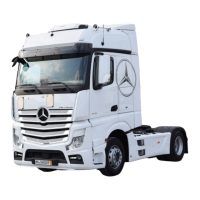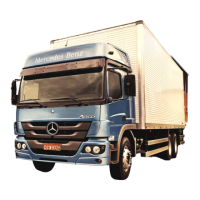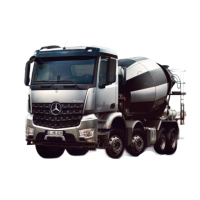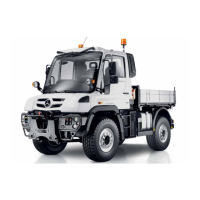46
General information
Recovery
Towing and Recovery | Actros, Antos (Model 963), Arocs (Model 964)
General safety information
$WARNING
When recovering the vehicle with a gear engaged and
the ignition switched on, there is a danger that the en-
gine could start and the vehicle could drive o out of
control. Before recovering, make sure that the ignition
in the vehicle is switched o. Disconnect the batteries
if the ignition cannot be switched o or if the cab is
inaccessible.
Force application points
ËThe force application points referred to below do
not have an innite load capacity. They should only
be regarded as suitable points for the application
of external forces and are intended for experienced
recovery experts.
Application of these instructions is le to the
discretion of the recovery experts. The steering may
be damaged if the vehicle is towed with recovery tools
which are fastened to the wheels/hubs on steering
axles.
• To minimize the bending stress and the frame load, the
areas of the connecting points between the longitudinal
frame members and the frame crossmembers are most
suitable. The straps used should be as wide as possible
so as not to damage any detachable frame parts, lines,
cables and hoses.
• Use as many force application points as possible.
• One-sided pulling will cause distortion or cracking of the
frame.
• The towing straps should form an isosceles triangle with
the smallest possible angle.
• Use load-compensating rollers to ensure that the pulling
force is equal on both sides.
• Avoid towing at an angle wherever possible. A towing
angle of max. 15° to the longitudinal axis of the vehicle
must not be exceeded.
• The utmost care is to be exercised when applying external
forces to the axles and axle connecting components.
• When pulling in the longitudinal direction, always use a
towing crossmember and a 2nd towing eye if possible.
Before recovering
M If possible, unload the vehicle rst, especially vehicles
with box bodies. This reduces the towing forces required.
Further damage to the vehicle can be reduced to a
minimum.
M If it is not possible to unload the vehicle, choose as many
force application points as possible.
Straightening the vehicle
M Apply parking brake.
M Use as many force application points as possible or apply
the forces in the vicinity of frame crossmembers. Use
straps.
M If possible, assist the procedure using inatable jacks.
M The forces can be distributed evenly by using towing
crossmembers, guide pulleys or load compensation
rollers.
M Tractor/semitrailer combinations should be straightened
at the front and rear simultaneously.
M Absorb the straightening forces. Do not drop the vehicle
in its suspension.
Aerstraightening
ËDo not start the engine. Accumulations of engine oil
in the exhaust system, in the charge air cooler, in the
entire engine intake tract, in the cylinder head or in
the cylinders themselves could cause the engine to
overrev and/or suer an oil hammer during a start
attempt. This could result in engine damage. Have
the engine and the entire intake tract checked at a
qualied workshop before restarting the engine.
Aerrecovering
Aer recovery, check all the safety components, see
page47.
Vehicles with air suspension: Check the air suspension bel-
lows for damage and whether they operate correctly and are
properly seated in the guides. To do this, set the highest and
lowest settings on the operating unit and check the behavior
of the air suspension bellows. The air suspension bellows
must roll up and down evenly.
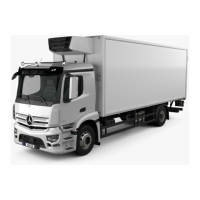
